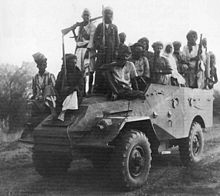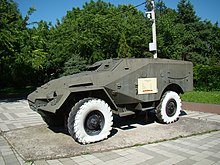BTR-40
The first was armed with two coaxial 14.5 mm KPVT heavy machine guns on a rotatable mount which was protected by armour plate at the front and sides.
[citation needed] The vehicle's drawbacks, such as its poor cross-country performance and problems with crossing water obstacles, compelled the design team to produce, in late 1954, what was planned to be an amphibious variant of the BTR-40.
During the design process, the vehicle moved away from the APC concept and became an amphibious armoured scout car.
The vehicle has no roof and is normally covered with a tarpaulin to protect the crew, transported cargo or troops from rain and snow.
The APC variant has no permanent armament but it has pintle mounts for three 7.62 mm SGMB medium machine guns, one at the front of the troop compartment and the other two at the sides.
The vehicle also has two firing ports on both sides of the hull which allow up to four soldiers to use their weapons while being protected by the APC's armour.
The turning angle is 7.5 m. The vehicle has the 10RT-12 receiving and airing radio which has a range of 20–25 km and a winch at the front, with a maximum capacity of 4.5 tonnes and 70 m of cable.
The BTR-40 began to enter service with two other Warsaw Pact members in late 1949, namely East Germany and Poland, where it was used as a standard APC until more advanced vehicles like the BTR-152 were available.
The vehicle was also exported to North Korea, probably as part of a military assistance programme during the Korean War, where it saw combat for the first time.
[6] BTR-40 also saw combat service during the North Yemen Civil War during which at least one was captured from the Egyptians by the royalist guerrillas.





